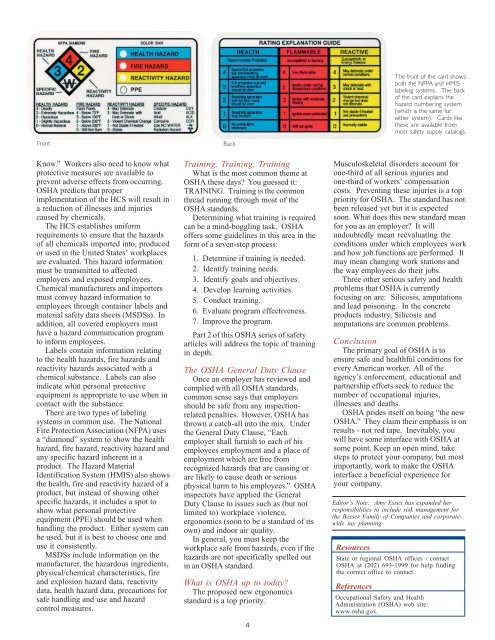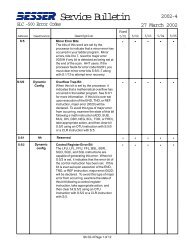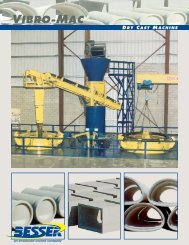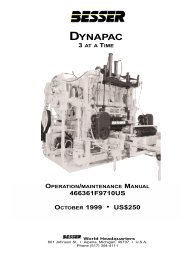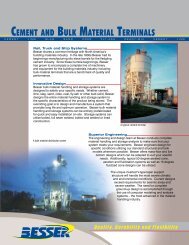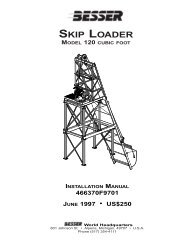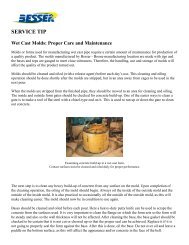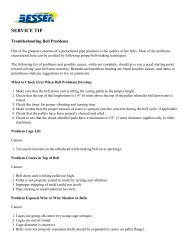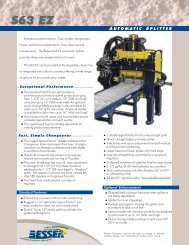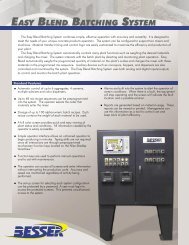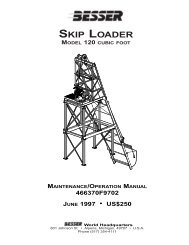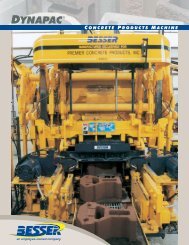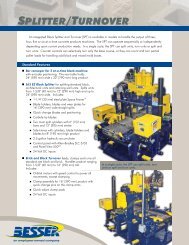Safety Bulletin - Besser Company
Safety Bulletin - Besser Company
Safety Bulletin - Besser Company
Create successful ePaper yourself
Turn your PDF publications into a flip-book with our unique Google optimized e-Paper software.
Front Back<br />
Know.” Workers also need to know what<br />
protective measures are available to<br />
prevent adverse effects from occurring.<br />
OSHA predicts that proper<br />
implementation of the HCS will result in<br />
a reduction of illnesses and injuries<br />
caused by chemicals.<br />
The HCS establishes uniform<br />
requirements to ensure that the hazards<br />
of all chemicals imported into, produced<br />
or used in the United States’ workplaces<br />
are evaluated. This hazard information<br />
must be transmitted to affected<br />
employers and exposed employees.<br />
Chemical manufacturers and importers<br />
must convey hazard information to<br />
employees through container labels and<br />
material safety data sheets (MSDSs). In<br />
addition, all covered employers must<br />
have a hazard communication program<br />
to inform employees.<br />
Labels contain information relating<br />
to the health hazards, fire hazards and<br />
reactivity hazards associated with a<br />
chemical substance. Labels can also<br />
indicate what personal protective<br />
equipment is appropriate to use when in<br />
contact with the substance.<br />
There are two types of labeling<br />
systems in common use. The National<br />
Fire Protection Association (NFPA) uses<br />
a “diamond” system to show the health<br />
hazard, fire hazard, reactivity hazard and<br />
any specific hazard inherent in a<br />
product. The Hazard Material<br />
Identification System (HMIS) also shows<br />
the health, fire and reactivity hazard of a<br />
product, but instead of showing other<br />
specific hazards, it includes a spot to<br />
show what personal protective<br />
equipment (PPE) should be used when<br />
handling the product. Either system can<br />
be used, but it is best to choose one and<br />
use it consistently.<br />
MSDSs include information on the<br />
manufacturer, the hazardous ingredients,<br />
physical/chemical characteristics, fire<br />
and explosion hazard data, reactivity<br />
data, health hazard data, precautions for<br />
safe handling and use and hazard<br />
control measures.<br />
Training, Training, Training<br />
What is the most common theme at<br />
OSHA these days? You guessed it:<br />
TRAINING. Training is the common<br />
thread running through most of the<br />
OSHA standards.<br />
Determining what training is required<br />
can be a mind-boggling task. OSHA<br />
offers some guidelines in this area in the<br />
form of a seven-step process:<br />
1. Determine if training is needed.<br />
2. Identify training needs.<br />
3. Identify goals and objectives.<br />
4. Develop learning activities.<br />
5. Conduct training.<br />
6. Evaluate program effectiveness.<br />
7. Improve the program.<br />
Part 2 of this OSHA series of safety<br />
articles will address the topic of training<br />
in depth.<br />
The OSHA General Duty Clause<br />
Once an employer has reviewed and<br />
complied with all OSHA standards,<br />
common sense says that employers<br />
should be safe from any inspectionrelated<br />
penalties. However, OSHA has<br />
thrown a catch-all into the mix. Under<br />
the General Duty Clause, “Each<br />
employer shall furnish to each of his<br />
employees employment and a place of<br />
employment which are free from<br />
recognized hazards that are causing or<br />
are likely to cause death or serious<br />
physical harm to his employees.” OSHA<br />
inspectors have applied the General<br />
Duty Clause to issues such as (but not<br />
limited to) workplace violence,<br />
ergonomics (soon to be a standard of its<br />
own) and indoor air quality.<br />
In general, you must keep the<br />
workplace safe from hazards, even if the<br />
hazards are not specifically spelled out<br />
in an OSHA standard.<br />
What is OSHA up to today?<br />
The proposed new ergonomics<br />
standard is a top priority.<br />
4<br />
Resources<br />
State or regional OSHA offices - contact<br />
OSHA at (202) 693-1999 for help finding<br />
the correct office to contact.<br />
References<br />
Occupational <strong>Safety</strong> and Health<br />
Administration (OSHA) web site:<br />
www.osha.gov.<br />
The front of the card shows<br />
both the NFPA and HMIS<br />
labeling systems. The back<br />
of the card explains the<br />
hazard numbering system<br />
(which is the same for<br />
either system). Cards like<br />
these are available from<br />
most safety supply catalogs.<br />
Musculoskeletal disorders account for<br />
one-third of all serious injuries and<br />
one-third of workers’ compensation<br />
costs. Preventing these injuries is a top<br />
priority for OSHA. The standard has not<br />
been released yet but it is expected<br />
soon. What does this new standard mean<br />
for you as an employer? It will<br />
undoubtedly mean reevaluating the<br />
conditions under which employees work<br />
and how job functions are performed. It<br />
may mean changing work stations and<br />
the way employees do their jobs.<br />
Three other serious safety and health<br />
problems that OSHA is currently<br />
focusing on are: Silicosis, amputations<br />
and lead poisoning. In the concrete<br />
products industry, Silicosis and<br />
amputations are common problems.<br />
Conclusion<br />
The primary goal of OSHA is to<br />
ensure safe and healthful conditions for<br />
every American worker. All of the<br />
agency’s enforcement, educational and<br />
partnership efforts seek to reduce the<br />
number of occupational injuries,<br />
illnesses and deaths.<br />
OSHA prides itself on being “the new<br />
OSHA.” They claim their emphasis is on<br />
results - not red tape. Inevitably, you<br />
will have some interface with OSHA at<br />
some point. Keep an open mind, take<br />
steps to protect your company, but most<br />
importantly, work to make the OSHA<br />
interface a beneficial experience for<br />
your company.<br />
Editor’s Note: Amy Essex has expanded her<br />
responsibilities to include risk management for<br />
the <strong>Besser</strong> Family of Companies and corporatewide<br />
tax planning.


